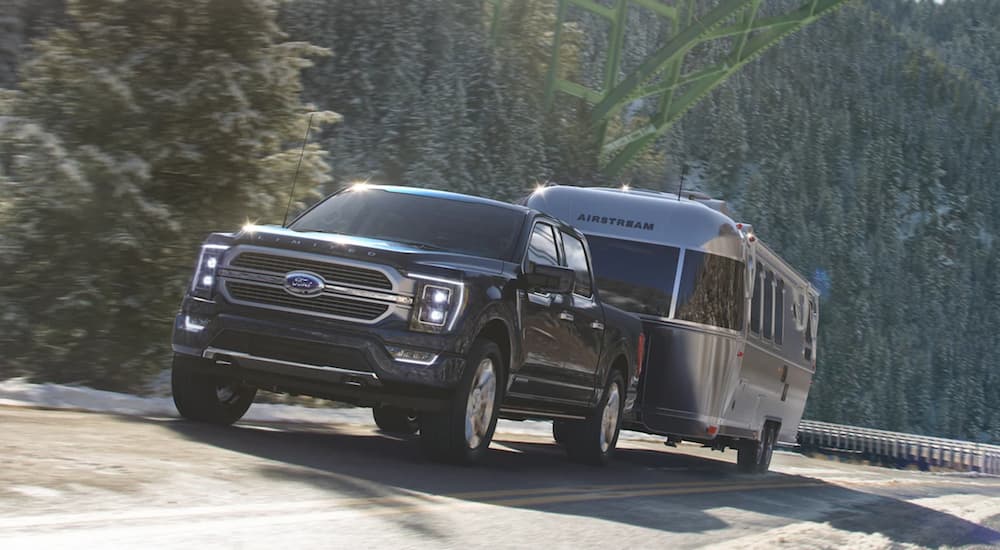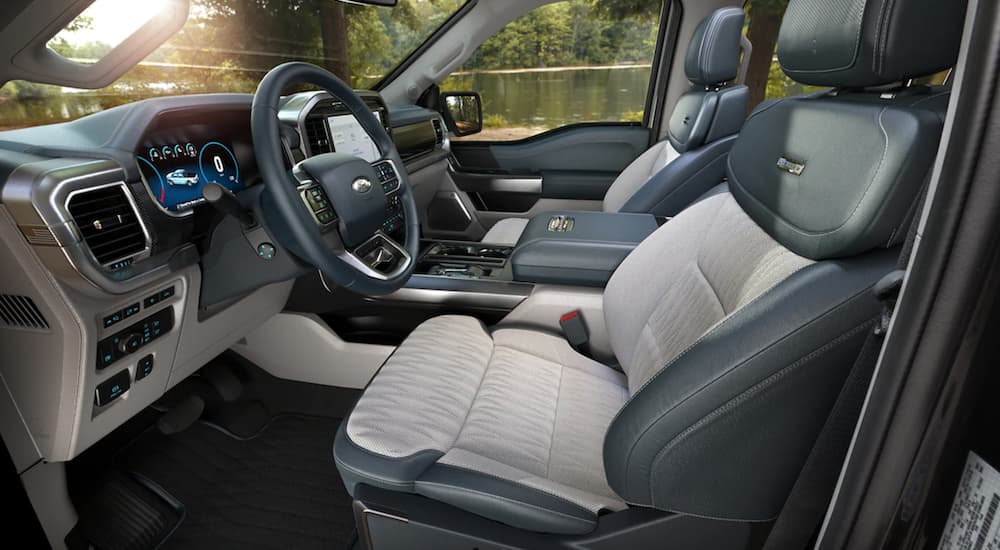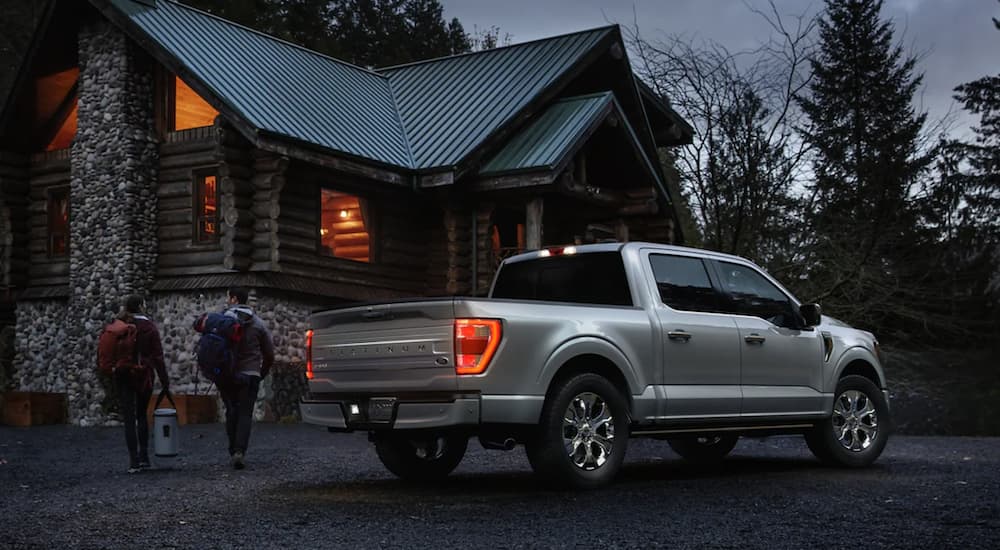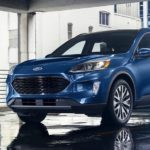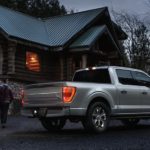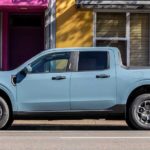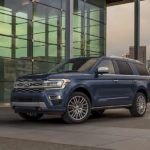After the 2021 launch of Ford’s completely redesigned F-150 pickup—and this year’s 2022 Ford F-150—all eyes focused on the companion EV, the Lightning. It makes sense, since the all-electric Lightning represents the beginning of the automaker’s very aggressive electrification strategy. One doesn’t need to completely abandon combustion engine technology to achieve better fuel economy, though, which is why Ford’s 3.5-liter PowerBoost full hybrid engine is such a breath of fresh air (no low-emissions pun intended).
Some buyers aren’t ready to pull the trigger on an EV—particularly those in need of a full-size pickup truck. Note that we threw in the word need. As the pickup demographic expands to include wealthy urban and suburban buyers who might never visit a job site, there’s still a core buyer whose criteria certainly lean more utilitarian. For these more traditional truck buyers, switching to an all-electric powertrain represents too big of a technology leap—or risk. Still, none would argue that a truck with better fuel economy ratings and no loss of capability is preferable.
That’s where Ford’s genius hybrid engine comes in. Channeling the best of gas and battery power, this powertrain delivers impressive performance numbers alongside towing and hauling capability. It offers hesitant buyers a gentle transition into the new age of zero-emissions driving—a way to get their feet wet without diving into the deep end of the pool. Here’s why it’s genius.
Ford’s Hybrid Engine Technology
Let’s get the stats out of the way first because, let’s face it, the choice to deviate from a big block V8 or throaty diesel all boils down to numbers. Ford’s 3.5-liter PowerBoost V6 hybrid engine generates 430 horsepower and a commanding 570 lb-ft of torque. With all that power, hybrid F-150 pickups can tow up to 12,700 pounds and haul a max of 2,120 pounds. Those are comforting specs for commercial buyers, or others for whom capability is key.
Just say the word “hybrid” and delicate vehicles like the Toyota Prius come to mind. However, hybrid powertrains have come a long way since their early, tree-hugging, Birkenstock-wearing roots. The “Built Ford Tough” truck tagline is more than just marketing speak—it’s a credo that undergirds every rig in the lineup. The best-selling F-150, as Ford’s flagship truck, maintains its 35-year win streak primarily because it is, in fact, tough. Expect nothing less from the hybrid powertrain, either.
Ford is so surefooted at engineering alternative fuel powertrains that this hybrid engine not only maintains the “Built Ford Tough” standards; it leads them. According to Ford, the full hybrid powertrain is the F-150’s most powerful engine, exceeding even the physically larger 5.0-liter V8—a popular option capable of producing 400 horsepower and 410 lb-ft of torque. We get that it’s a mental shift for V8-loving buyers to shift down to a hybrid V6. But remember: trends in engine technology favor an inverse relationship between size and output.
Hybrid powertrains aren’t only about the combustion engine, of course. Ford’s includes a 1.5-kWh lithium-ion battery and a modular hybrid transmission that does something a traditional engine can’t; it acts as a standalone generator. The included battery provides 2.4 kW of juice to Ford’s Pro Power Onboard system. This is substantially more than that of the hybrid F-150’s competitors (and 100% more than any gas-powered alternative). Access to that much exportable power is an undeniable benefit for buyers.
Capability Without Sacrifice
Certainly, the numbers tell a clear story about the hybrid F-150’s capabilities. A deeper dive into Ford’s engineering efforts, though, should inspire even more confidence. To ensure the battery’s durability, Ford took it through a punishing series of tests. Engineers simulated harsh driving conditions, like deep potholes and other road hazards, on a test machine, violently shaking the battery for hours. According to a 2020 press release, the battery endured the equivalent of 10 years of hard driving—and passed with flying colors.
Ford also performed on-the-road endurance testing, hooking up a trailer and hauling the max 12,700 pounds up a 3,500-foot grade in the Mojave Desert. The 11.4-mile climb and 6% grade were further dampened by the region’s sweltering temperatures—yet the F-150 successfully and capably completed the climb multiple times, with no hint of performance degradation. A similar test took place at Ford’s proving grounds, with an F-150 carrying the max 2,120-pound payload, netting similar results.
The automaker didn’t stop there, taking the hybrid F-150 off-road in the Anza-Borrego Desert. There, the pickup tackled sand dunes; rocky terrain; and barren, dried-up mud trails exactly as expected. For off-road adventurers, this is great news. Not only will your F-150 happily bounce across whatever backcountry trail you travel, but you’ll also worry less about running out of gas. Concentrating 10 years of hard driving in a scant 82 hours may seem like overkill, but Ford engineers understood that a hybrid powertrain on its face might be a hard sell.
Because the hybrid powertrain employs Ford’s existing 3.5-liter EcoBoost engine and mates it to a hybrid-compatible version of the lineup’s 10-speed transmission, there’s enough familiarity to inspire confidence. Ford offers the hybrid on all F-150 trims, and it’s available as an upgrade whether you choose a two-wheel drive or 4×4 model. Also, it’s notable that the editors at Car and Driver achieved a zero-to-sixty time of just 5.4 seconds behind the wheel of a hybrid-powered 4×4 F-150 Lariat at the test track.
A Shortcut to Good Environmental Stewardship
Perhaps most exciting about Ford’s hybrid V6 is the promise of better fuel economy and a better driving range. Rough estimates put fuel economy ratings at 23 mpg combined, a remarkable feat for a motor tuned to deliver such high horsepower and torque ratings. Consider that the traditional twin-turbo 3.5-liter V6 sans electric motor achieves as little as 19 mpg and the argument for gas-powered engines loses much of its luster.
Exclusive to the hybrid powertrain, drivers can choose between electric-only mode, gas-only mode, or—of course—hybrid. For diehard truck owners, expect an element of disbelief as a day of visiting job sites and running around town for work barely moves the fuel gauge. Juxtapose that with its performance and capability stats, and it’s hard not to feel like you’re dreaming.
In full-electric mode, don’t expect a lot of range. Unfortunately, the electric motor is only capable of a scant 47 horsepower on its own. We expect this to improve over the next several model years, but even in its current form, it’s sufficient to make a meaningful dent in fuel consumption. Considering the hybrid powertrain bridges the chasm between traditional gas power and the full-electric propulsion found on the F-150 Lightning, there’s hope for future improvement.
Let’s not forget the importance of Pro Power Onboard, the system that allows your F-150 to morph into a powerful mobile generator. The included 120-volt outlets each offer 20 amps of power, so flip down the tailgate and feel free to use it as a work surface. If you’re working at a remote site, Pro Power Onboard is a lifesaver. It comes in two flavors: 2.4 or 7.2 kW. The former gets you two outlets, and the latter ups the quantity to four and adds a single 30-amp, 240-volt outlet for good measure.
Hybrids Aren’t Just for Hippies
We get that the hybrid car stigma is tough to shake. Ford gets it too, which is why the F-150’s available hybrid powertrain offers the best performance and capability specs in the six-engine lineup. It’s no happy accident. Instead, this is Ford’s best effort to encourage traditional pickup buyers to opt into environmentally friendly technology. Given the company’s commitment to electrification, the hybrid F-150 is but a stepping stone—but it’s a compelling one.
If a new 2022 F-150 pickup is on your list, make sure you test drive a hybrid. Whether you’re moved by better fuel economy or a sense that it’s the environmentally responsible thing to do doesn’t matter. What matters is that Ford built a hybrid powertrain that rivals any gas- or diesel-powered alternative. If you’re chasing optimal, all-around capability, a new Ford hybrid is the one you want.
